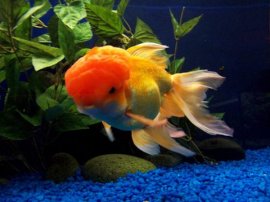
 Goldfish need appropriate temperatures to remain healthy.
Goldfish need appropriate temperatures to remain healthy.
Goldfish are cold water fish who live in cool lakes, streams and rivers. However, the fact that they are cold water fish does not mean that they should be kept in frigid temperatures. When water is too cold, goldfish may stop eating, begin hibernating or die.
Proper Water Temperature
Goldfish thrive at temperatures between 65 and 72 degrees Fahrenheit, which is roughly room temperature or slightly below. When temperatures are too high, goldfish may become sluggish and overheat. At temperatures below 60 degrees, they may stop eating or become lethargic. When temperatures drop below 50 to 55 degrees, they begin hibernating by hovering at the bottom of the pond. Goldfish do not eat during hibernation.
Behavioral Changes
Fish stop eating at temperatures below 60 degrees because in the wild this is a cue that winter is coming and the fish should begin preparing for hibernation. In captivity, however, fish are more likely to starve to death if temperatures remain at such low levels and never drop to hibernation levels.
Hibernation
When temperatures dip below 55 degrees after a steady period of dropping, fish go into hibernation. Some fish owners opt to hibernate their outdoor pond fish. However, hibernation does pose some risks to goldfish, and unhealthy or underweight goldfish may die. You must add an air stone to your pond during hibernation to ensure the fish get adequate oxygen, particularly if the pond freezes over.
Maintaining Water Temperature
Unless your goldfish live outside in a cool area, your fish do not need a heater. However, in cool areas, provide your fish with a pond heater and regularly monitor the water temperature. While goldfish can hibernate for a few months, if they're forced to hibernate for more than a season, they may die. When housing goldfish indoors, place them in a cool, draft-free area of your house and check the temperature regularly.









